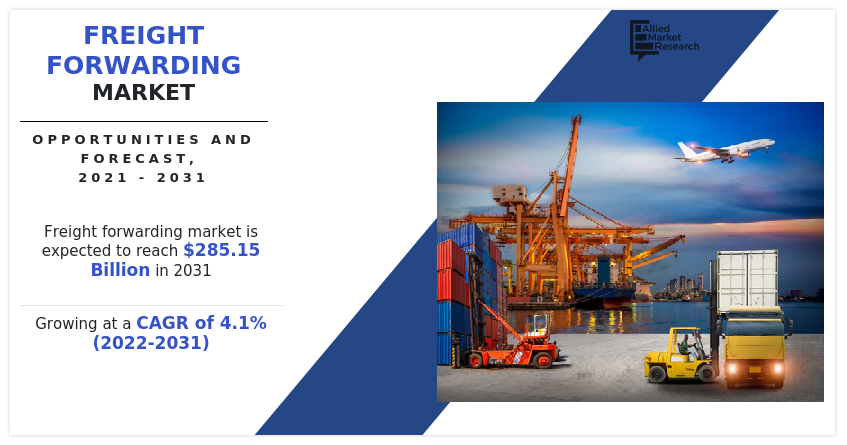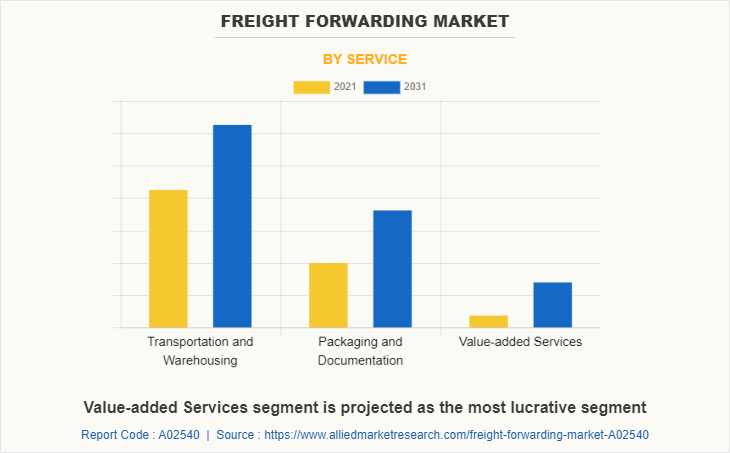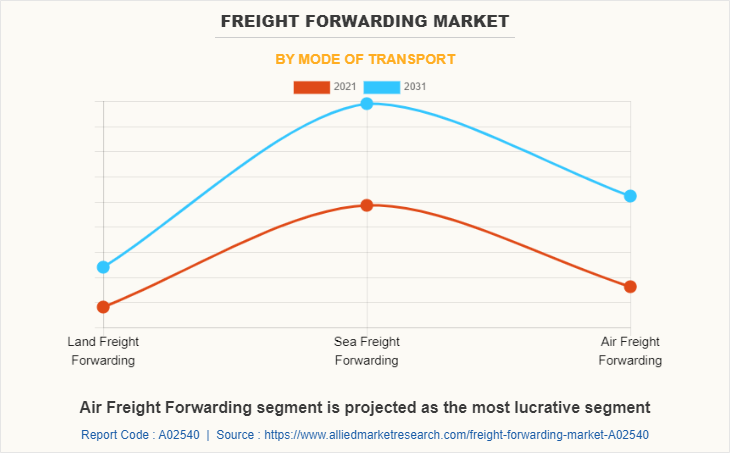The global freight forwarding market was valued at $192.50 billion in 2021, and is projected to reach $285.15 billion by 2031, growing at a CAGR of 4.1% from 2022 to 2031.

Freight forwarding is the process of organizing, coordinating, and shipping of goods from one place to another across international borders through a single or multiple carriers. The shipment of the goods occurs via air, land or sea. The company responsible for organizing the shipment is known as freight forwarder. Freight forwarders manage the risks and benefits of shipping both nationally and internationally by performing the required tasks such as freight rate negotiations, container tracking, customs documentation and freight consolidation. Moreover, freight forwarding comprises numerous stages such as export haulage, export customs clearance, origin handling, import customs clearance, destination handling and import haulage.
Growth of the global freight forwarding market is propelling, owing to growth in international trade, expansion of the e-commerce industry globally, and rise in the free trade agreements between nations. However, stringent emission regulations restrain growth of the market. Furthermore, technological advancements, and cost cutting & lead time reduced by adopting multimodal system are factors expected to offer growth opportunities during the forecast period.

The freight forwarding market is segmented on the basis of service, mode of transport, logistics model, customer type, end-use industry, and region. By service, it is segmented into transportation & warehousing, packaging & documentation, and value-added services. By mode of transport, it is classified into air freight forwarding, sea freight forwarding, and land freight forwarding (road & rail).
By customer type, it is bifurcated into B2B and B2C. By end-use industry, it is fragmented into retail & e-commerce, manufacturing, healthcare, automotive, and others. By region, the report is analyzed across North America, Europe, Asia-Pacific, and LAMEA.
Some leading companies profiled in the freight forwarding market report comprises Bollore Logistics, CEVA Logistics, DB Schenker, DHL Global Forwarding, Dimerco, DSV Panalpina A/S, Expeditors International, Fedex, Hellman Worldwide Logistics, Kuehne+Nagel International AG, MGF (Manitoulin Global Forwarding), Nippon Express Co., Ltd., Transporteca, UPS Supply Chain Solutions, and UBER Freight LLC.

Growth in international trade
International trade is the exchange of goods and services between countries and continents. It has an important share in GDP in different countries. Recently, COVID-19 affected the international trade across the globe and resulted in slowdown of economic activities among countries. COVID-19 pandemic brought global economy to a standstill and decline in international trade activities was observed. Emerging countries such as China and India also faced temporary suspension of manufacturing and logistics activities, owing to government enforced lockdown.
However, as the COVID-19 vaccine was introduced and lockdown restrictions were lifted, international trade activities started to resume. Several major trading economies has observed rise in exports and imports levels in 2021. In addition, as per the United Nations Conference on Trade and Development (UNCTAD), the global trade has reached a record level of $28.5 trillion in 2021 which is an increase of 25% as compared to 2020 and 13% as compared to 2019.
Moreover, rise in e-commerce activities also contributed toward growth of international trade and is expected to continue to contribute in upcoming years. Thus, growth in international trade is the major factor that drives growth of the freight forwarding market during the forecast period.
Expansion of e-commerce industry globally
E-commerce refers to buying and selling of goods by utilizing internet. E-commerce is a virtual store where goods & services do not require any physical space and are sold through websites. The e-commerce industry utilizes logistics services to manage and oversee supply chain of e-commerce companies, thus, allowing these companies to focus on marketing and other business operations. Easy accessibility, convenient shopping experiences, and heavy discounts & offers make e-commerce a popular medium for purchase of a wide variety of products. These factors have collectively contributed toward growth of the freight forwarding industry for e-commerce services.
In addition, COVID-19 also contributed in growth of the e-commerce industry across the globe. Several governments-imposed lockdown in their regions to restrict spread of the virus. As there were no access to physical marketplace, people started to purchase goods or products online, which, in turn, resulted in growth of the e-commerce sector.
Moreover, rise of the e-commerce industry has forced freight forwarders to adopt digital technologies to address the increasing demand of customers. They have also started to use artificial intelligence, internet of things (IoT), and other technologies to ensure timely delivery of goods or products to customers. Thus, expansion of the e-commerce industry globally propels growth of the digital freight forwarding market.

The freight forwarding market is segmented into Service, Mode of Transport, Customer Type and End-use Industry.
Key Benefits For Stakeholders
- This report provides a quantitative analysis of the market segments, current trends, estimations, and dynamics of the freight forwarding market analysis from 2021 to 2031 to identify the prevailing freight forwarding market opportunities.
- The market research is offered along with information related to key drivers, restraints, and opportunities.
- Porter's five forces analysis highlights the potency of buyers and suppliers to enable stakeholders make profit-oriented business decisions and strengthen their supplier-buyer network.
- In-depth analysis of the freight forwarding market segmentation assists to determine the prevailing market opportunities.
- Major countries in each region are mapped according to their revenue contribution to the global market.
- Market player positioning facilitates benchmarking and provides a clear understanding of the present position of the market players.
- The report includes the analysis of the regional as well as global freight forwarding market trends, key players, market segments, application areas, and market growth strategies.
Freight forwarding Market Report Highlights
| Aspects | Details |
| By Service |
|
| By Mode of Transport |
|
| By Customer Type |
|
| By End-use Industry |
|
| By Region |
|
| Key Market Players | Dimerco, Nippon Express Co., Ltd., Deutsche Post DHL, Kuehne+Nagel International AG, Transporteca, MGF, Hellmann Worldwide Logistics, Uber Freight LLC, CEVA Logistics AG, DSV A/S, Schenker Deutschland AG, Expeditors International of Washington, Inc., FedEx, Bolloré Logistics, United Parcel Service of America, Inc. |
Analyst Review
The freight forwarding market is witnessing a steady growth. Increase in international trade, expansion of the e-commerce industry worldwide, and rise in free trade agreements between nations.
Several technological advancements have been taking place in the freight industry, which directly contributes in expansion of the freight industry. Artificial intelligence integration is gaining traction in the freight forwarding market. Artificial intelligence compile real-time data, enter it into a transport management system (TMS) and trigger a set of activities which in turn provides updates about the container or shipment status. In a similar manner, internet of things (IoT) enables freight industry to track shipments and their status efficiently by making use of sensors, databases, and cloud systems. Moreover, technologies such as advanced machine learning and cloud-based solutions that are being developed are expected to contribute in increasing freight transportation performance and efficiency.
Greater demand for multimodal transport is expected to offer growth opportunities during the forecast period. Multimodal transport or system is a type of freight that comprises use of more than one mode of transportation to transport goods from one place to another. It can be a combination of two or more of any means of transport such as air, land or sea freight. Presently, logistics service providers are focusing on reducing cost of transportation and timely delivery of goods to customer. Number of orders to be delivered in limited time is rising, as a result of which logistics companies are adopting multimodal transportation system to increase efficiency in the supply chain. Advantage of multimodal transport is that it uses most efficient combination of transport modes, while keeping freight costs down. For instance, APL Logistics (Japan-based freight forwarding and Transportation Company) provides ShipMax solution to its customers. It includes pairing with compatible trucking partners as well as allows customers to take advantage of better load utilization and delivery optimization, thus enabling customers to maximize transportation budget. Therefore, cost cutting and lead time reduction by adopting multimodal system offer remunerative opportunities for expansion of the global freight forwarding market during the forecast period.
The global freight forwarding market was valued at $192.5 billion in 2021 and is projected to reach $285.2 billion in 2031, registering a CAGR of 4.1%.
Asia-Pacific is the largest regional market for freight forwarding.
Manufacturing is the leading application of freight forwarding market.
Some leading companies in the freight forwarding market include Bollore Logistics, CEVA Logistics, DB Schenker, DHL Global Forwarding, Dimerco, DSV Panalpina A/S, Expeditors International, Fedex, Hellman Worldwide Logistics, Kuehne+Nagel International AG, MGF (Manitoulin Global Forwarding), Nippon Express Co., Ltd., Transporteca, UPS Supply Chain Solutions, and UBER Freight LLC.
Some upcoming trends in the freight forwarding market include expansion of e-commerce industry, and enhanced offerings of value added services by market players.
Loading Table Of Content...



